HCS350: Agency Analysis and Management Report on NCCTRC
VerifiedAdded on 2022/08/24
|11
|3051
|19
Report
AI Summary
This report provides a detailed analysis of the National Critical Care and Trauma Response Centre (NCCTRC), an Australian government agency focused on emergency medical response, particularly during natural disasters. The report examines the NCCTRC's historical context, vision, and mission, emphasizing its role in providing academic and clinical leadership in critical care and trauma. It delves into the organization's functional structure and collaborative culture, highlighting the importance of communication and employee collaboration. The report identifies the NCCTRC's beneficiaries as those affected by natural disasters, both within Australia and internationally, and outlines the major services offered, including emergency healthcare support, disaster response research, and medical training. It discusses the service delivery models employed, specifically the Human Service and Public Health Models, and analyzes the links between organizational structure, culture, and service delivery. The report concludes by assessing the NCCTRC's fit within the broader humanitarian assistance system, emphasizing its contribution to social work and community development.
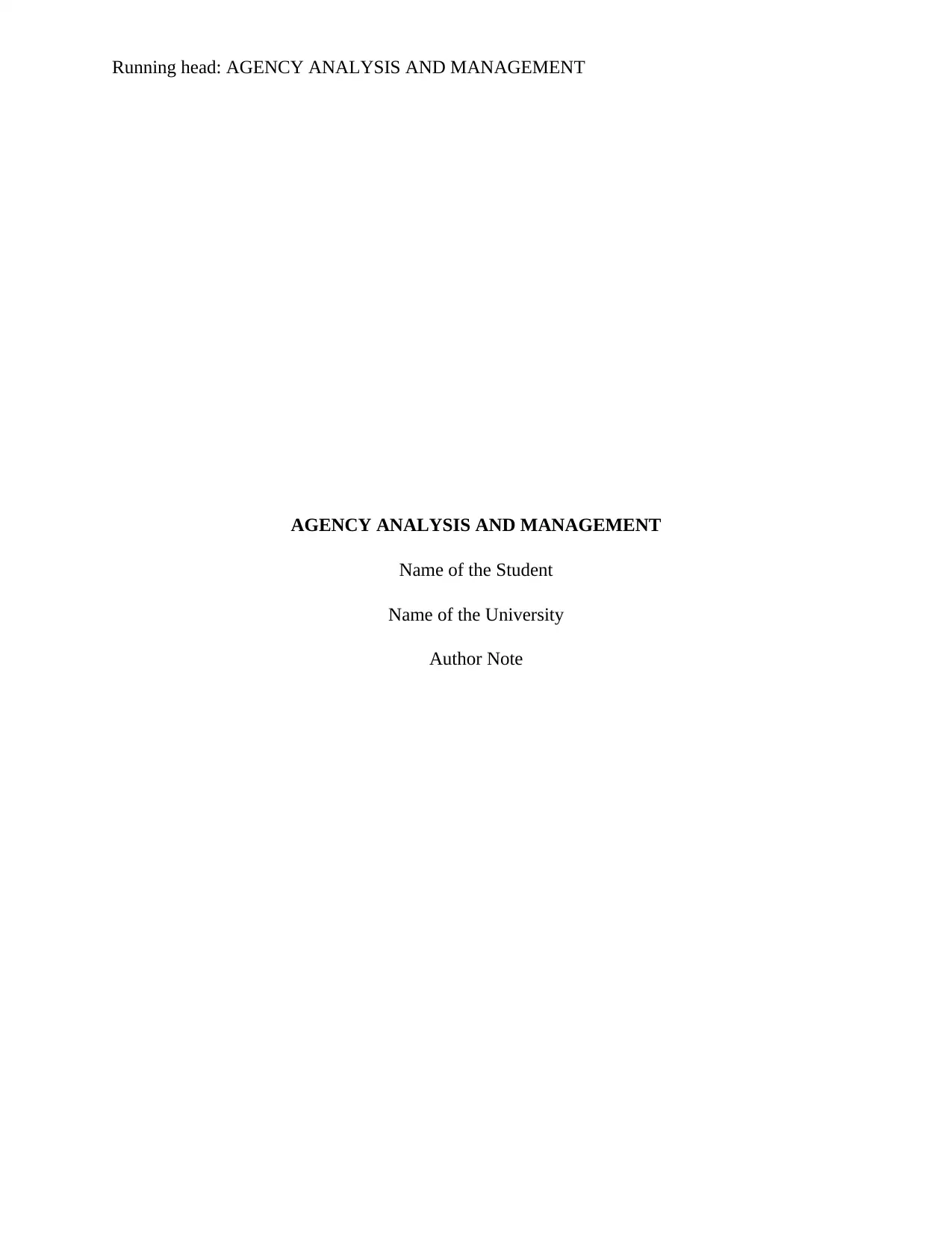
Running head: AGENCY ANALYSIS AND MANAGEMENT
AGENCY ANALYSIS AND MANAGEMENT
Name of the Student
Name of the University
Author Note
AGENCY ANALYSIS AND MANAGEMENT
Name of the Student
Name of the University
Author Note
Paraphrase This Document
Need a fresh take? Get an instant paraphrase of this document with our AI Paraphraser
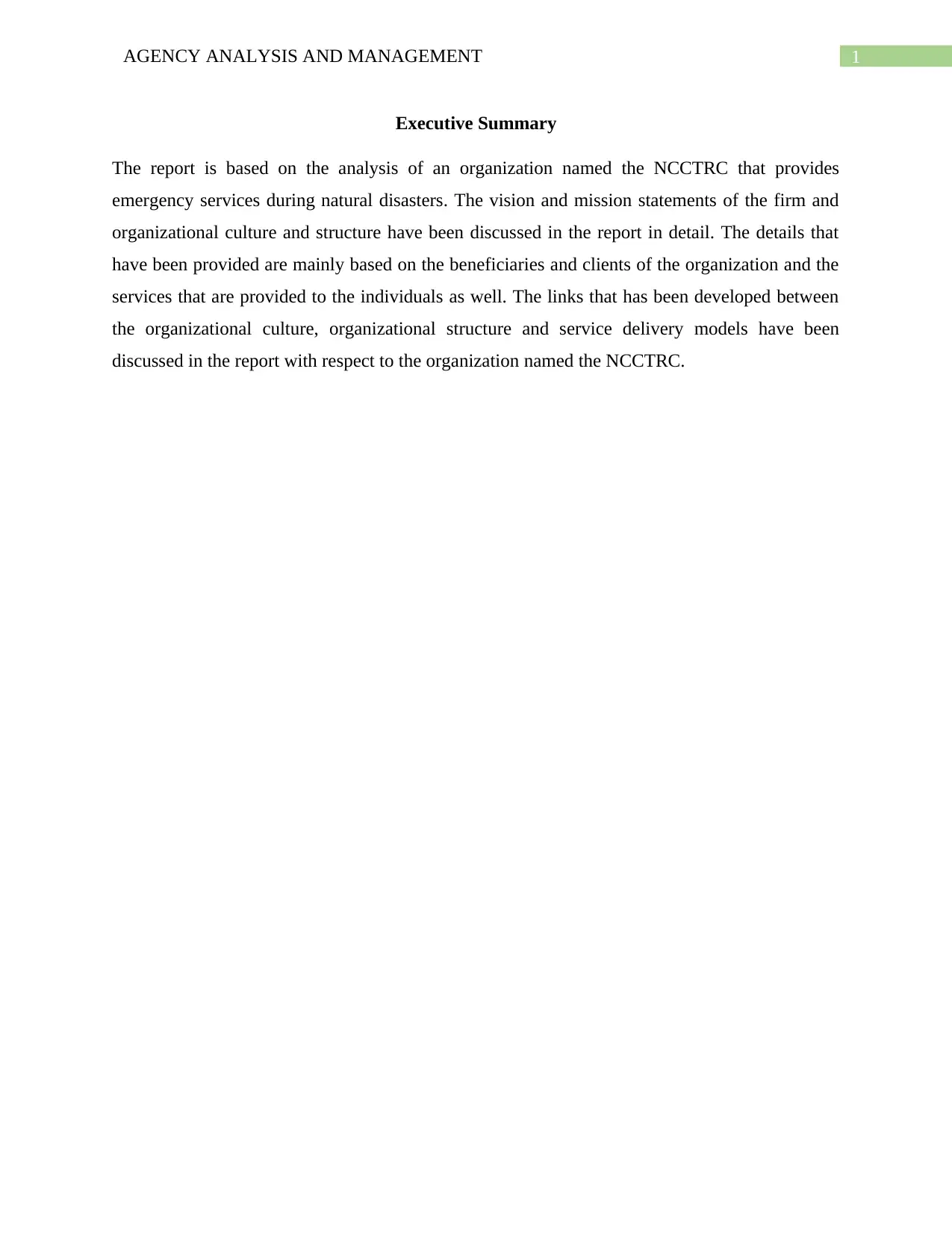
1AGENCY ANALYSIS AND MANAGEMENT
Executive Summary
The report is based on the analysis of an organization named the NCCTRC that provides
emergency services during natural disasters. The vision and mission statements of the firm and
organizational culture and structure have been discussed in the report in detail. The details that
have been provided are mainly based on the beneficiaries and clients of the organization and the
services that are provided to the individuals as well. The links that has been developed between
the organizational culture, organizational structure and service delivery models have been
discussed in the report with respect to the organization named the NCCTRC.
Executive Summary
The report is based on the analysis of an organization named the NCCTRC that provides
emergency services during natural disasters. The vision and mission statements of the firm and
organizational culture and structure have been discussed in the report in detail. The details that
have been provided are mainly based on the beneficiaries and clients of the organization and the
services that are provided to the individuals as well. The links that has been developed between
the organizational culture, organizational structure and service delivery models have been
discussed in the report with respect to the organization named the NCCTRC.
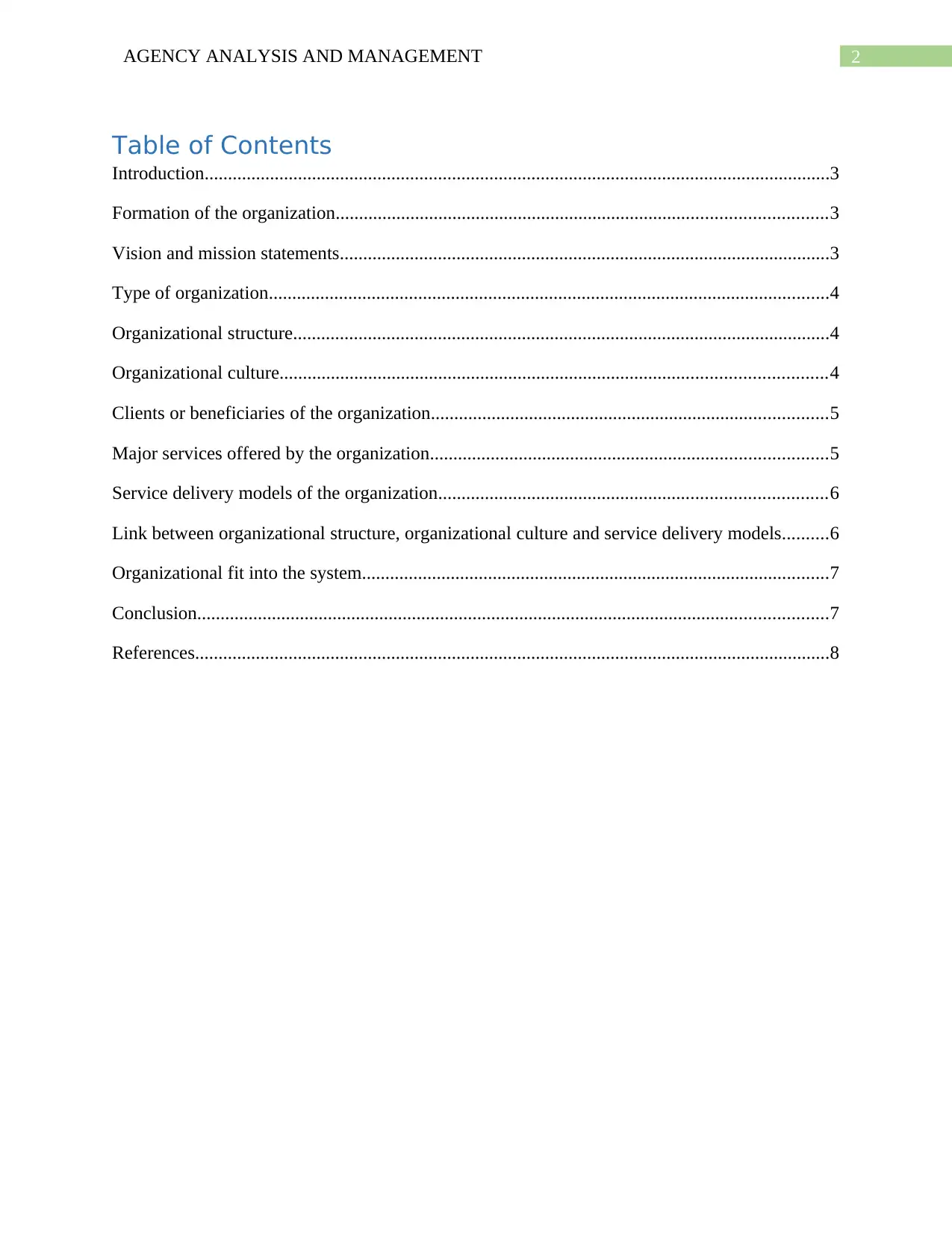
2AGENCY ANALYSIS AND MANAGEMENT
Table of Contents
Introduction......................................................................................................................................3
Formation of the organization.........................................................................................................3
Vision and mission statements.........................................................................................................3
Type of organization........................................................................................................................4
Organizational structure...................................................................................................................4
Organizational culture.....................................................................................................................4
Clients or beneficiaries of the organization.....................................................................................5
Major services offered by the organization.....................................................................................5
Service delivery models of the organization...................................................................................6
Link between organizational structure, organizational culture and service delivery models..........6
Organizational fit into the system....................................................................................................7
Conclusion.......................................................................................................................................7
References........................................................................................................................................8
Table of Contents
Introduction......................................................................................................................................3
Formation of the organization.........................................................................................................3
Vision and mission statements.........................................................................................................3
Type of organization........................................................................................................................4
Organizational structure...................................................................................................................4
Organizational culture.....................................................................................................................4
Clients or beneficiaries of the organization.....................................................................................5
Major services offered by the organization.....................................................................................5
Service delivery models of the organization...................................................................................6
Link between organizational structure, organizational culture and service delivery models..........6
Organizational fit into the system....................................................................................................7
Conclusion.......................................................................................................................................7
References........................................................................................................................................8
⊘ This is a preview!⊘
Do you want full access?
Subscribe today to unlock all pages.

Trusted by 1+ million students worldwide
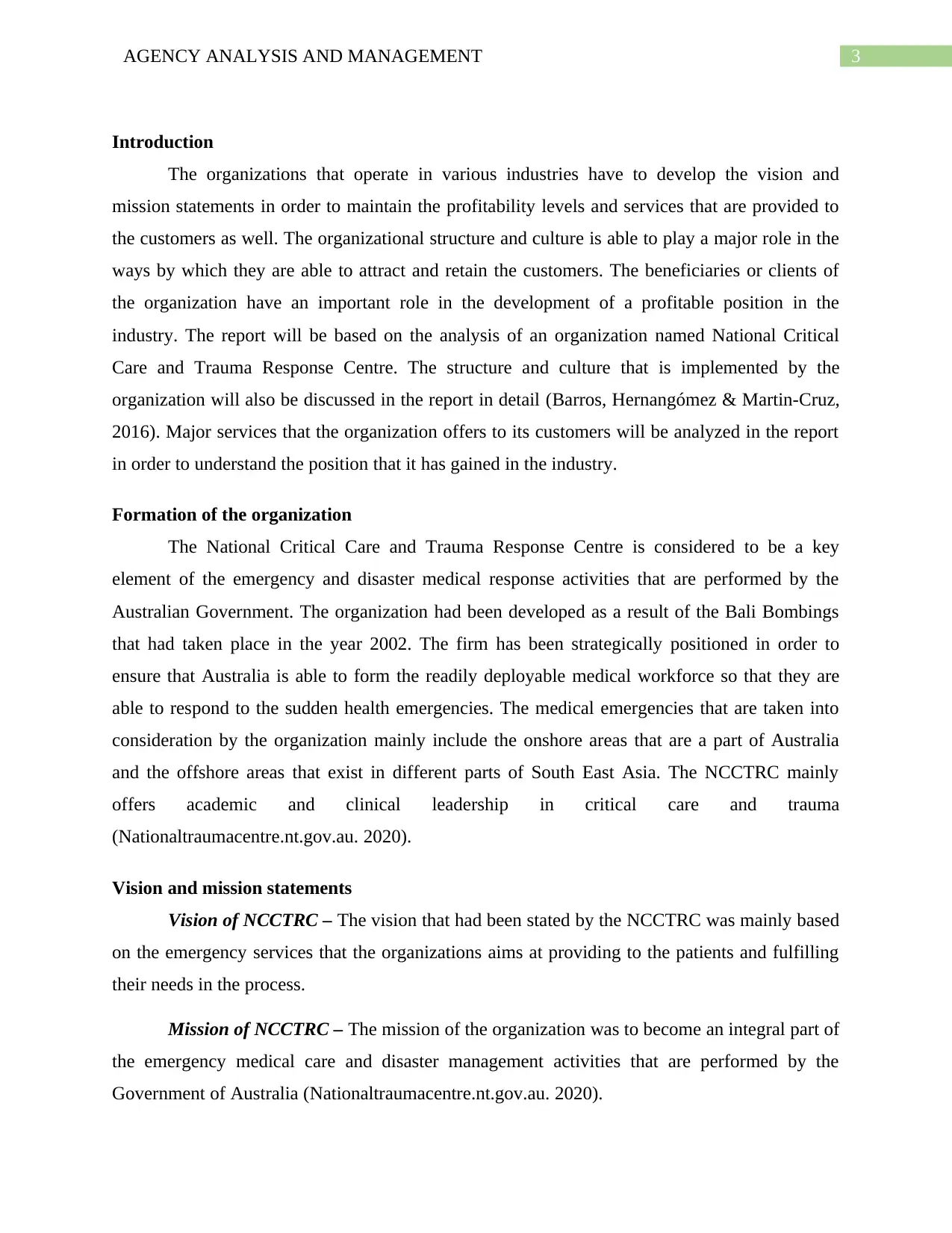
3AGENCY ANALYSIS AND MANAGEMENT
Introduction
The organizations that operate in various industries have to develop the vision and
mission statements in order to maintain the profitability levels and services that are provided to
the customers as well. The organizational structure and culture is able to play a major role in the
ways by which they are able to attract and retain the customers. The beneficiaries or clients of
the organization have an important role in the development of a profitable position in the
industry. The report will be based on the analysis of an organization named National Critical
Care and Trauma Response Centre. The structure and culture that is implemented by the
organization will also be discussed in the report in detail (Barros, Hernangómez & Martin-Cruz,
2016). Major services that the organization offers to its customers will be analyzed in the report
in order to understand the position that it has gained in the industry.
Formation of the organization
The National Critical Care and Trauma Response Centre is considered to be a key
element of the emergency and disaster medical response activities that are performed by the
Australian Government. The organization had been developed as a result of the Bali Bombings
that had taken place in the year 2002. The firm has been strategically positioned in order to
ensure that Australia is able to form the readily deployable medical workforce so that they are
able to respond to the sudden health emergencies. The medical emergencies that are taken into
consideration by the organization mainly include the onshore areas that are a part of Australia
and the offshore areas that exist in different parts of South East Asia. The NCCTRC mainly
offers academic and clinical leadership in critical care and trauma
(Nationaltraumacentre.nt.gov.au. 2020).
Vision and mission statements
Vision of NCCTRC – The vision that had been stated by the NCCTRC was mainly based
on the emergency services that the organizations aims at providing to the patients and fulfilling
their needs in the process.
Mission of NCCTRC – The mission of the organization was to become an integral part of
the emergency medical care and disaster management activities that are performed by the
Government of Australia (Nationaltraumacentre.nt.gov.au. 2020).
Introduction
The organizations that operate in various industries have to develop the vision and
mission statements in order to maintain the profitability levels and services that are provided to
the customers as well. The organizational structure and culture is able to play a major role in the
ways by which they are able to attract and retain the customers. The beneficiaries or clients of
the organization have an important role in the development of a profitable position in the
industry. The report will be based on the analysis of an organization named National Critical
Care and Trauma Response Centre. The structure and culture that is implemented by the
organization will also be discussed in the report in detail (Barros, Hernangómez & Martin-Cruz,
2016). Major services that the organization offers to its customers will be analyzed in the report
in order to understand the position that it has gained in the industry.
Formation of the organization
The National Critical Care and Trauma Response Centre is considered to be a key
element of the emergency and disaster medical response activities that are performed by the
Australian Government. The organization had been developed as a result of the Bali Bombings
that had taken place in the year 2002. The firm has been strategically positioned in order to
ensure that Australia is able to form the readily deployable medical workforce so that they are
able to respond to the sudden health emergencies. The medical emergencies that are taken into
consideration by the organization mainly include the onshore areas that are a part of Australia
and the offshore areas that exist in different parts of South East Asia. The NCCTRC mainly
offers academic and clinical leadership in critical care and trauma
(Nationaltraumacentre.nt.gov.au. 2020).
Vision and mission statements
Vision of NCCTRC – The vision that had been stated by the NCCTRC was mainly based
on the emergency services that the organizations aims at providing to the patients and fulfilling
their needs in the process.
Mission of NCCTRC – The mission of the organization was to become an integral part of
the emergency medical care and disaster management activities that are performed by the
Government of Australia (Nationaltraumacentre.nt.gov.au. 2020).
Paraphrase This Document
Need a fresh take? Get an instant paraphrase of this document with our AI Paraphraser
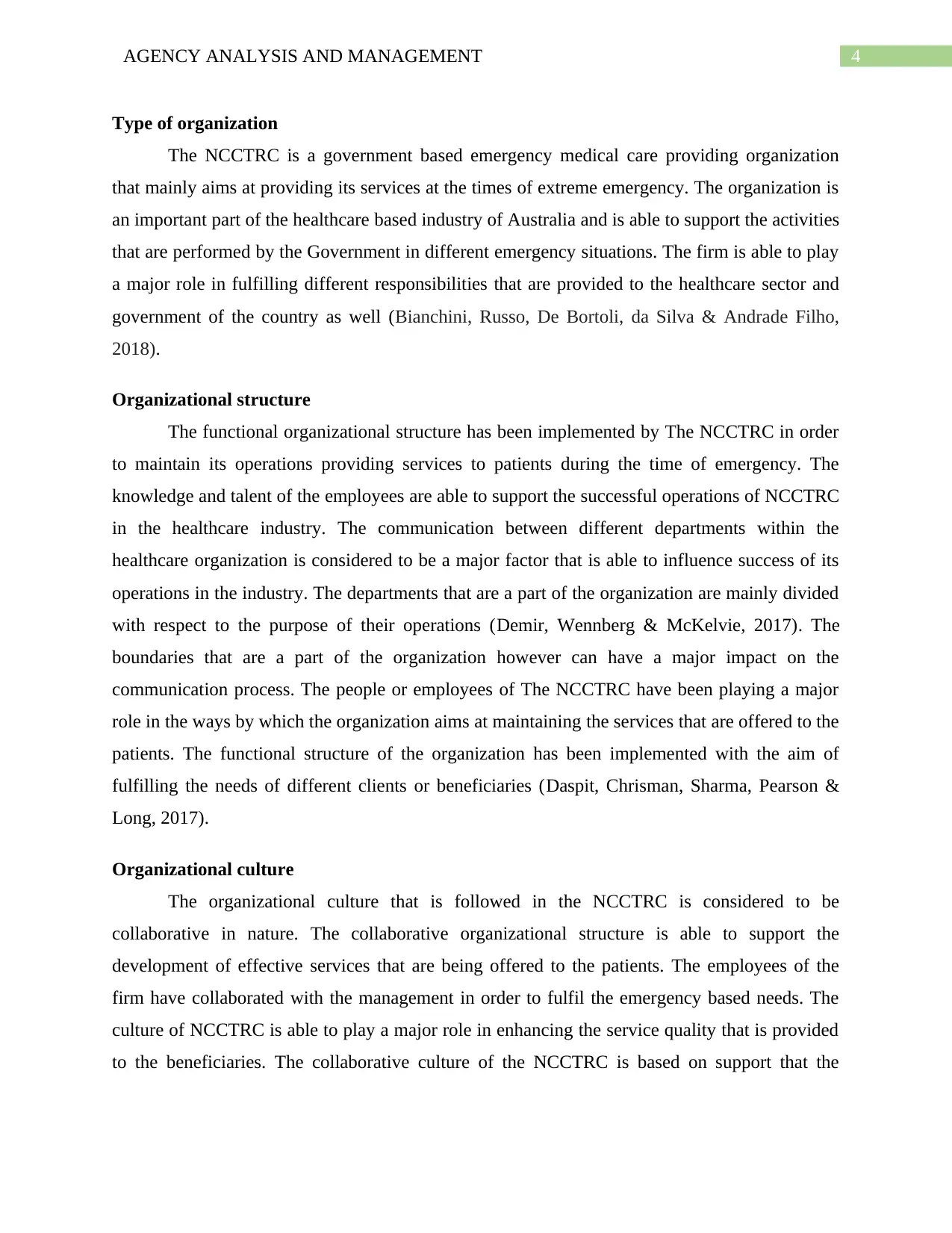
4AGENCY ANALYSIS AND MANAGEMENT
Type of organization
The NCCTRC is a government based emergency medical care providing organization
that mainly aims at providing its services at the times of extreme emergency. The organization is
an important part of the healthcare based industry of Australia and is able to support the activities
that are performed by the Government in different emergency situations. The firm is able to play
a major role in fulfilling different responsibilities that are provided to the healthcare sector and
government of the country as well (Bianchini, Russo, De Bortoli, da Silva & Andrade Filho,
2018).
Organizational structure
The functional organizational structure has been implemented by The NCCTRC in order
to maintain its operations providing services to patients during the time of emergency. The
knowledge and talent of the employees are able to support the successful operations of NCCTRC
in the healthcare industry. The communication between different departments within the
healthcare organization is considered to be a major factor that is able to influence success of its
operations in the industry. The departments that are a part of the organization are mainly divided
with respect to the purpose of their operations (Demir, Wennberg & McKelvie, 2017). The
boundaries that are a part of the organization however can have a major impact on the
communication process. The people or employees of The NCCTRC have been playing a major
role in the ways by which the organization aims at maintaining the services that are offered to the
patients. The functional structure of the organization has been implemented with the aim of
fulfilling the needs of different clients or beneficiaries (Daspit, Chrisman, Sharma, Pearson &
Long, 2017).
Organizational culture
The organizational culture that is followed in the NCCTRC is considered to be
collaborative in nature. The collaborative organizational structure is able to support the
development of effective services that are being offered to the patients. The employees of the
firm have collaborated with the management in order to fulfil the emergency based needs. The
culture of NCCTRC is able to play a major role in enhancing the service quality that is provided
to the beneficiaries. The collaborative culture of the NCCTRC is based on support that the
Type of organization
The NCCTRC is a government based emergency medical care providing organization
that mainly aims at providing its services at the times of extreme emergency. The organization is
an important part of the healthcare based industry of Australia and is able to support the activities
that are performed by the Government in different emergency situations. The firm is able to play
a major role in fulfilling different responsibilities that are provided to the healthcare sector and
government of the country as well (Bianchini, Russo, De Bortoli, da Silva & Andrade Filho,
2018).
Organizational structure
The functional organizational structure has been implemented by The NCCTRC in order
to maintain its operations providing services to patients during the time of emergency. The
knowledge and talent of the employees are able to support the successful operations of NCCTRC
in the healthcare industry. The communication between different departments within the
healthcare organization is considered to be a major factor that is able to influence success of its
operations in the industry. The departments that are a part of the organization are mainly divided
with respect to the purpose of their operations (Demir, Wennberg & McKelvie, 2017). The
boundaries that are a part of the organization however can have a major impact on the
communication process. The people or employees of The NCCTRC have been playing a major
role in the ways by which the organization aims at maintaining the services that are offered to the
patients. The functional structure of the organization has been implemented with the aim of
fulfilling the needs of different clients or beneficiaries (Daspit, Chrisman, Sharma, Pearson &
Long, 2017).
Organizational culture
The organizational culture that is followed in the NCCTRC is considered to be
collaborative in nature. The collaborative organizational structure is able to support the
development of effective services that are being offered to the patients. The employees of the
firm have collaborated with the management in order to fulfil the emergency based needs. The
culture of NCCTRC is able to play a major role in enhancing the service quality that is provided
to the beneficiaries. The collaborative culture of the NCCTRC is based on support that the
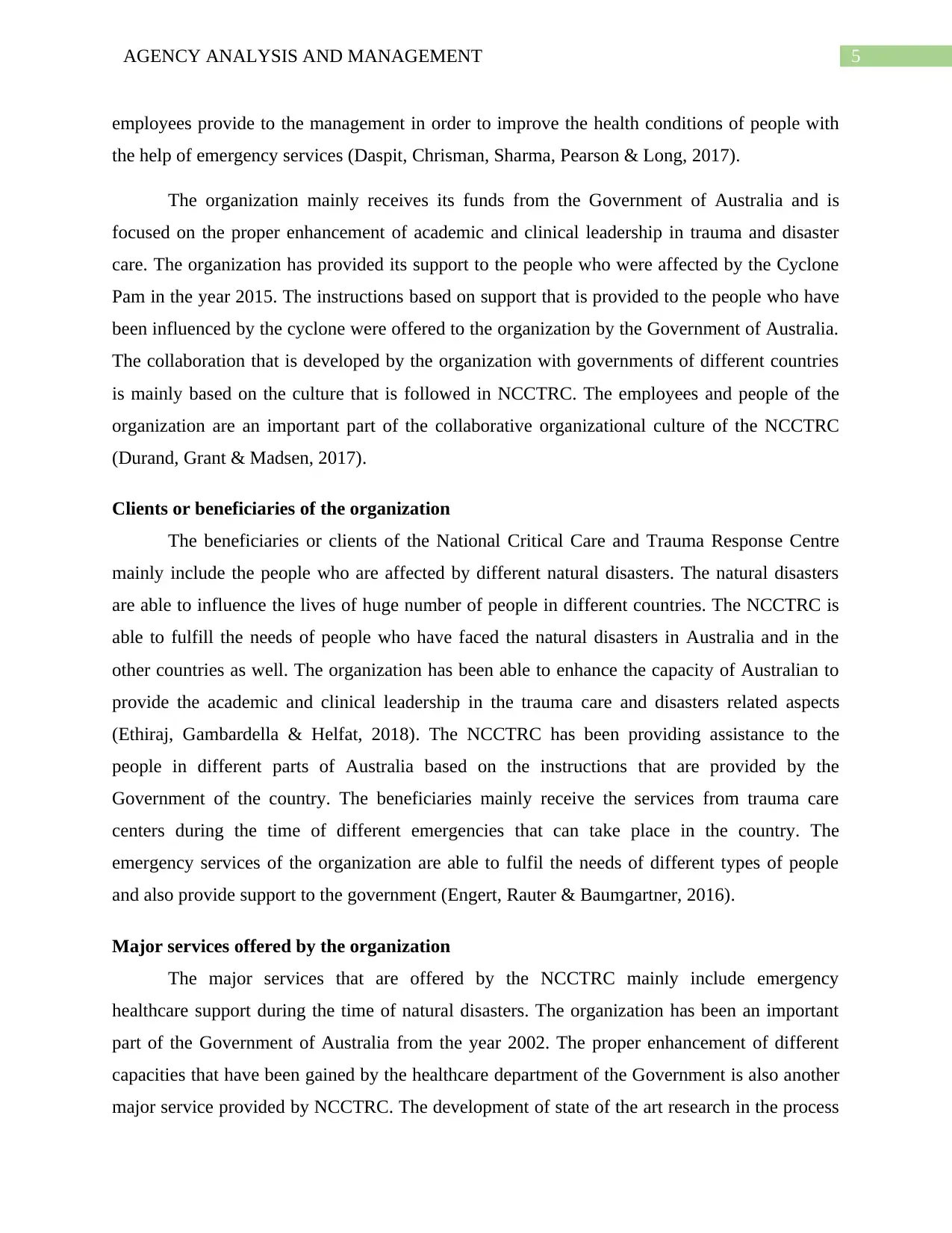
5AGENCY ANALYSIS AND MANAGEMENT
employees provide to the management in order to improve the health conditions of people with
the help of emergency services (Daspit, Chrisman, Sharma, Pearson & Long, 2017).
The organization mainly receives its funds from the Government of Australia and is
focused on the proper enhancement of academic and clinical leadership in trauma and disaster
care. The organization has provided its support to the people who were affected by the Cyclone
Pam in the year 2015. The instructions based on support that is provided to the people who have
been influenced by the cyclone were offered to the organization by the Government of Australia.
The collaboration that is developed by the organization with governments of different countries
is mainly based on the culture that is followed in NCCTRC. The employees and people of the
organization are an important part of the collaborative organizational culture of the NCCTRC
(Durand, Grant & Madsen, 2017).
Clients or beneficiaries of the organization
The beneficiaries or clients of the National Critical Care and Trauma Response Centre
mainly include the people who are affected by different natural disasters. The natural disasters
are able to influence the lives of huge number of people in different countries. The NCCTRC is
able to fulfill the needs of people who have faced the natural disasters in Australia and in the
other countries as well. The organization has been able to enhance the capacity of Australian to
provide the academic and clinical leadership in the trauma care and disasters related aspects
(Ethiraj, Gambardella & Helfat, 2018). The NCCTRC has been providing assistance to the
people in different parts of Australia based on the instructions that are provided by the
Government of the country. The beneficiaries mainly receive the services from trauma care
centers during the time of different emergencies that can take place in the country. The
emergency services of the organization are able to fulfil the needs of different types of people
and also provide support to the government (Engert, Rauter & Baumgartner, 2016).
Major services offered by the organization
The major services that are offered by the NCCTRC mainly include emergency
healthcare support during the time of natural disasters. The organization has been an important
part of the Government of Australia from the year 2002. The proper enhancement of different
capacities that have been gained by the healthcare department of the Government is also another
major service provided by NCCTRC. The development of state of the art research in the process
employees provide to the management in order to improve the health conditions of people with
the help of emergency services (Daspit, Chrisman, Sharma, Pearson & Long, 2017).
The organization mainly receives its funds from the Government of Australia and is
focused on the proper enhancement of academic and clinical leadership in trauma and disaster
care. The organization has provided its support to the people who were affected by the Cyclone
Pam in the year 2015. The instructions based on support that is provided to the people who have
been influenced by the cyclone were offered to the organization by the Government of Australia.
The collaboration that is developed by the organization with governments of different countries
is mainly based on the culture that is followed in NCCTRC. The employees and people of the
organization are an important part of the collaborative organizational culture of the NCCTRC
(Durand, Grant & Madsen, 2017).
Clients or beneficiaries of the organization
The beneficiaries or clients of the National Critical Care and Trauma Response Centre
mainly include the people who are affected by different natural disasters. The natural disasters
are able to influence the lives of huge number of people in different countries. The NCCTRC is
able to fulfill the needs of people who have faced the natural disasters in Australia and in the
other countries as well. The organization has been able to enhance the capacity of Australian to
provide the academic and clinical leadership in the trauma care and disasters related aspects
(Ethiraj, Gambardella & Helfat, 2018). The NCCTRC has been providing assistance to the
people in different parts of Australia based on the instructions that are provided by the
Government of the country. The beneficiaries mainly receive the services from trauma care
centers during the time of different emergencies that can take place in the country. The
emergency services of the organization are able to fulfil the needs of different types of people
and also provide support to the government (Engert, Rauter & Baumgartner, 2016).
Major services offered by the organization
The major services that are offered by the NCCTRC mainly include emergency
healthcare support during the time of natural disasters. The organization has been an important
part of the Government of Australia from the year 2002. The proper enhancement of different
capacities that have been gained by the healthcare department of the Government is also another
major service provided by NCCTRC. The development of state of the art research in the process
⊘ This is a preview!⊘
Do you want full access?
Subscribe today to unlock all pages.

Trusted by 1+ million students worldwide
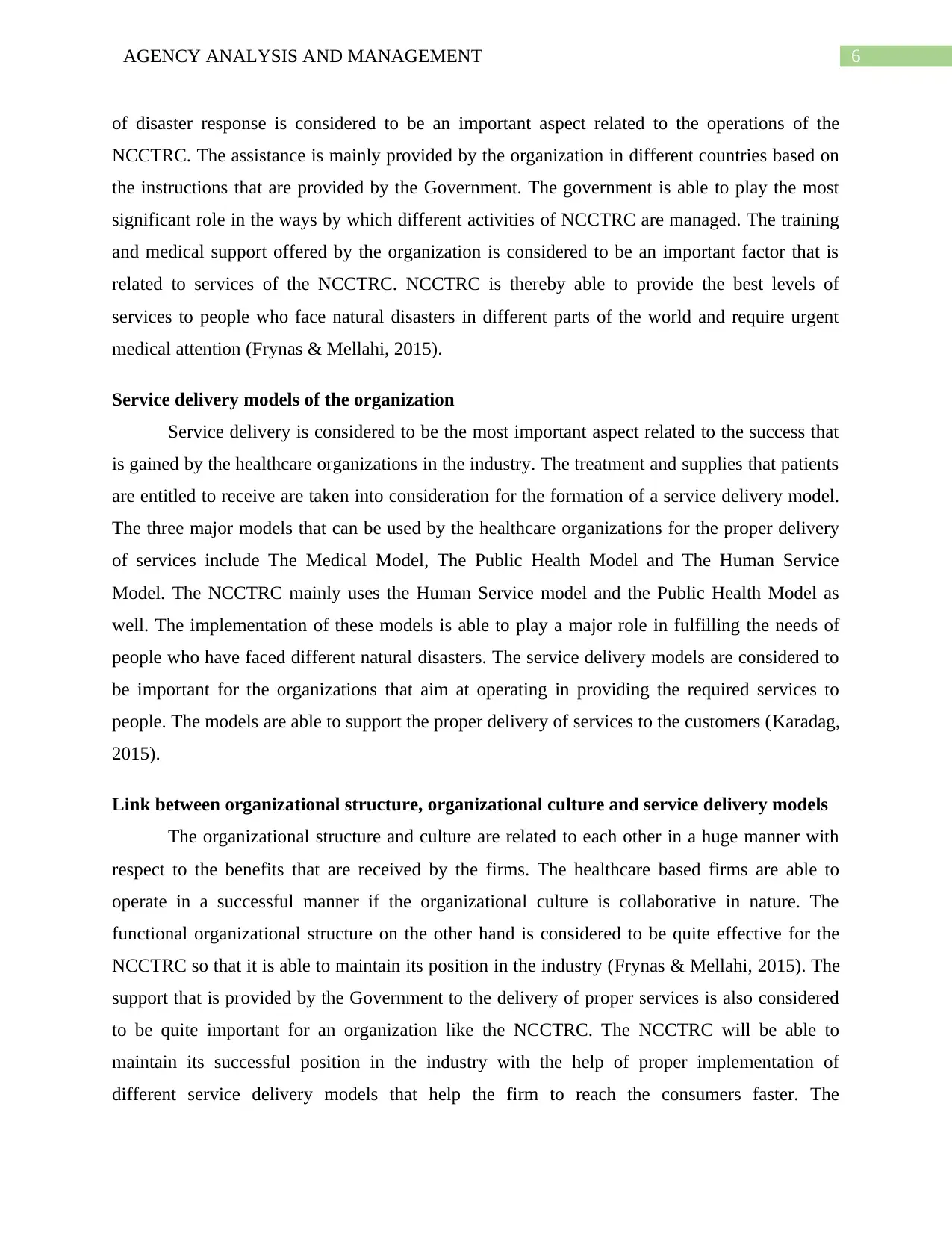
6AGENCY ANALYSIS AND MANAGEMENT
of disaster response is considered to be an important aspect related to the operations of the
NCCTRC. The assistance is mainly provided by the organization in different countries based on
the instructions that are provided by the Government. The government is able to play the most
significant role in the ways by which different activities of NCCTRC are managed. The training
and medical support offered by the organization is considered to be an important factor that is
related to services of the NCCTRC. NCCTRC is thereby able to provide the best levels of
services to people who face natural disasters in different parts of the world and require urgent
medical attention (Frynas & Mellahi, 2015).
Service delivery models of the organization
Service delivery is considered to be the most important aspect related to the success that
is gained by the healthcare organizations in the industry. The treatment and supplies that patients
are entitled to receive are taken into consideration for the formation of a service delivery model.
The three major models that can be used by the healthcare organizations for the proper delivery
of services include The Medical Model, The Public Health Model and The Human Service
Model. The NCCTRC mainly uses the Human Service model and the Public Health Model as
well. The implementation of these models is able to play a major role in fulfilling the needs of
people who have faced different natural disasters. The service delivery models are considered to
be important for the organizations that aim at operating in providing the required services to
people. The models are able to support the proper delivery of services to the customers (Karadag,
2015).
Link between organizational structure, organizational culture and service delivery models
The organizational structure and culture are related to each other in a huge manner with
respect to the benefits that are received by the firms. The healthcare based firms are able to
operate in a successful manner if the organizational culture is collaborative in nature. The
functional organizational structure on the other hand is considered to be quite effective for the
NCCTRC so that it is able to maintain its position in the industry (Frynas & Mellahi, 2015). The
support that is provided by the Government to the delivery of proper services is also considered
to be quite important for an organization like the NCCTRC. The NCCTRC will be able to
maintain its successful position in the industry with the help of proper implementation of
different service delivery models that help the firm to reach the consumers faster. The
of disaster response is considered to be an important aspect related to the operations of the
NCCTRC. The assistance is mainly provided by the organization in different countries based on
the instructions that are provided by the Government. The government is able to play the most
significant role in the ways by which different activities of NCCTRC are managed. The training
and medical support offered by the organization is considered to be an important factor that is
related to services of the NCCTRC. NCCTRC is thereby able to provide the best levels of
services to people who face natural disasters in different parts of the world and require urgent
medical attention (Frynas & Mellahi, 2015).
Service delivery models of the organization
Service delivery is considered to be the most important aspect related to the success that
is gained by the healthcare organizations in the industry. The treatment and supplies that patients
are entitled to receive are taken into consideration for the formation of a service delivery model.
The three major models that can be used by the healthcare organizations for the proper delivery
of services include The Medical Model, The Public Health Model and The Human Service
Model. The NCCTRC mainly uses the Human Service model and the Public Health Model as
well. The implementation of these models is able to play a major role in fulfilling the needs of
people who have faced different natural disasters. The service delivery models are considered to
be important for the organizations that aim at operating in providing the required services to
people. The models are able to support the proper delivery of services to the customers (Karadag,
2015).
Link between organizational structure, organizational culture and service delivery models
The organizational structure and culture are related to each other in a huge manner with
respect to the benefits that are received by the firms. The healthcare based firms are able to
operate in a successful manner if the organizational culture is collaborative in nature. The
functional organizational structure on the other hand is considered to be quite effective for the
NCCTRC so that it is able to maintain its position in the industry (Frynas & Mellahi, 2015). The
support that is provided by the Government to the delivery of proper services is also considered
to be quite important for an organization like the NCCTRC. The NCCTRC will be able to
maintain its successful position in the industry with the help of proper implementation of
different service delivery models that help the firm to reach the consumers faster. The
Paraphrase This Document
Need a fresh take? Get an instant paraphrase of this document with our AI Paraphraser
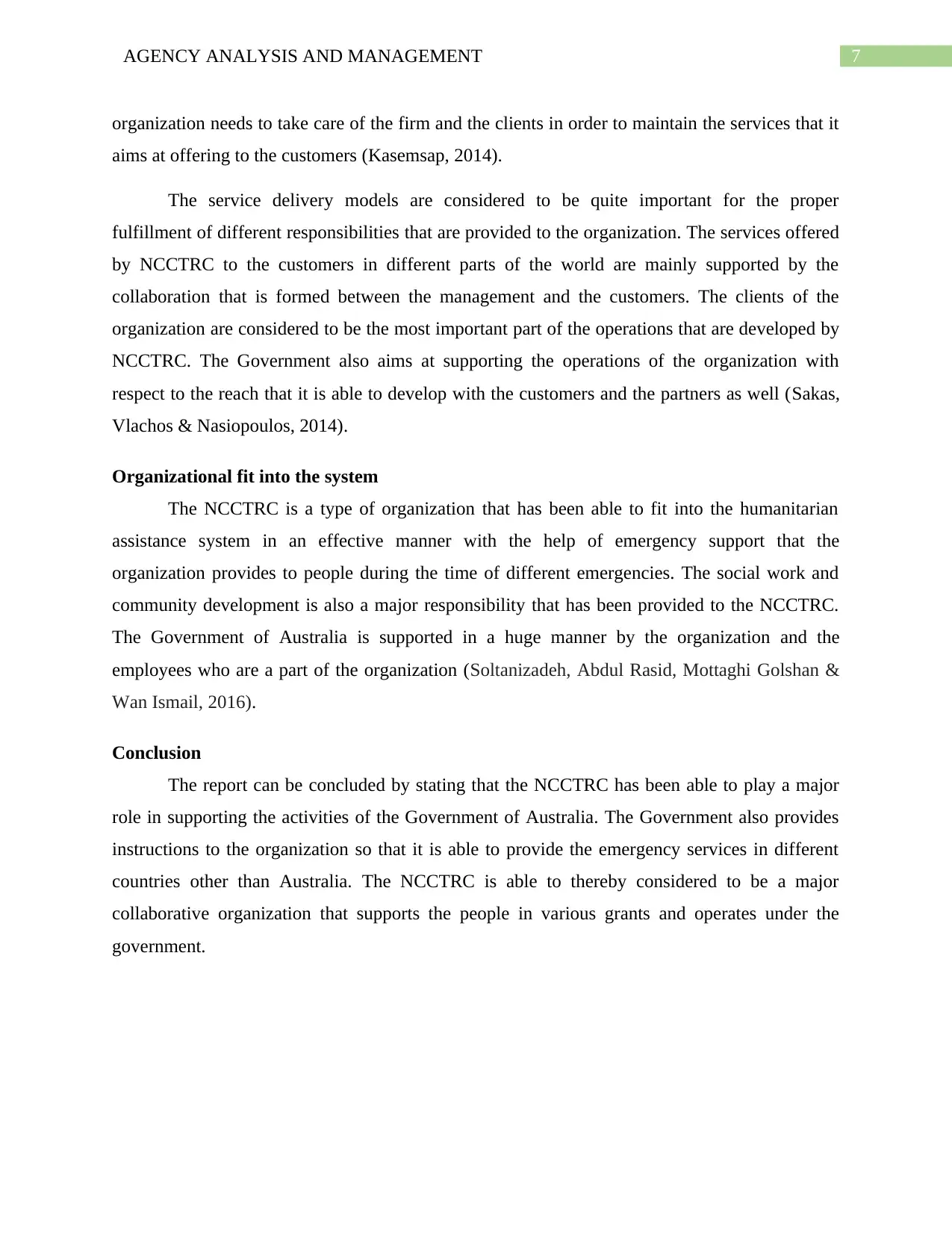
7AGENCY ANALYSIS AND MANAGEMENT
organization needs to take care of the firm and the clients in order to maintain the services that it
aims at offering to the customers (Kasemsap, 2014).
The service delivery models are considered to be quite important for the proper
fulfillment of different responsibilities that are provided to the organization. The services offered
by NCCTRC to the customers in different parts of the world are mainly supported by the
collaboration that is formed between the management and the customers. The clients of the
organization are considered to be the most important part of the operations that are developed by
NCCTRC. The Government also aims at supporting the operations of the organization with
respect to the reach that it is able to develop with the customers and the partners as well (Sakas,
Vlachos & Nasiopoulos, 2014).
Organizational fit into the system
The NCCTRC is a type of organization that has been able to fit into the humanitarian
assistance system in an effective manner with the help of emergency support that the
organization provides to people during the time of different emergencies. The social work and
community development is also a major responsibility that has been provided to the NCCTRC.
The Government of Australia is supported in a huge manner by the organization and the
employees who are a part of the organization (Soltanizadeh, Abdul Rasid, Mottaghi Golshan &
Wan Ismail, 2016).
Conclusion
The report can be concluded by stating that the NCCTRC has been able to play a major
role in supporting the activities of the Government of Australia. The Government also provides
instructions to the organization so that it is able to provide the emergency services in different
countries other than Australia. The NCCTRC is able to thereby considered to be a major
collaborative organization that supports the people in various grants and operates under the
government.
organization needs to take care of the firm and the clients in order to maintain the services that it
aims at offering to the customers (Kasemsap, 2014).
The service delivery models are considered to be quite important for the proper
fulfillment of different responsibilities that are provided to the organization. The services offered
by NCCTRC to the customers in different parts of the world are mainly supported by the
collaboration that is formed between the management and the customers. The clients of the
organization are considered to be the most important part of the operations that are developed by
NCCTRC. The Government also aims at supporting the operations of the organization with
respect to the reach that it is able to develop with the customers and the partners as well (Sakas,
Vlachos & Nasiopoulos, 2014).
Organizational fit into the system
The NCCTRC is a type of organization that has been able to fit into the humanitarian
assistance system in an effective manner with the help of emergency support that the
organization provides to people during the time of different emergencies. The social work and
community development is also a major responsibility that has been provided to the NCCTRC.
The Government of Australia is supported in a huge manner by the organization and the
employees who are a part of the organization (Soltanizadeh, Abdul Rasid, Mottaghi Golshan &
Wan Ismail, 2016).
Conclusion
The report can be concluded by stating that the NCCTRC has been able to play a major
role in supporting the activities of the Government of Australia. The Government also provides
instructions to the organization so that it is able to provide the emergency services in different
countries other than Australia. The NCCTRC is able to thereby considered to be a major
collaborative organization that supports the people in various grants and operates under the
government.
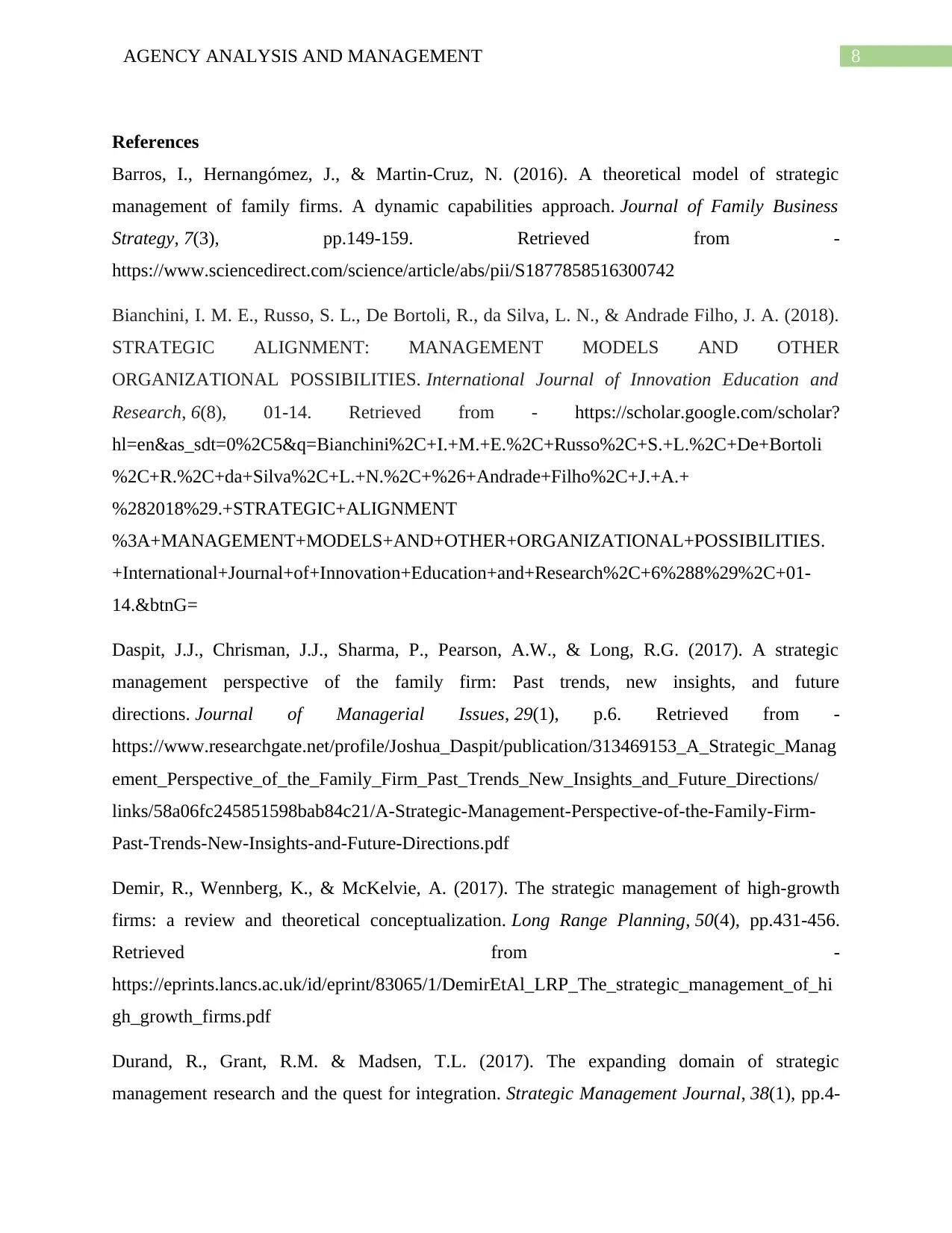
8AGENCY ANALYSIS AND MANAGEMENT
References
Barros, I., Hernangómez, J., & Martin-Cruz, N. (2016). A theoretical model of strategic
management of family firms. A dynamic capabilities approach. Journal of Family Business
Strategy, 7(3), pp.149-159. Retrieved from -
https://www.sciencedirect.com/science/article/abs/pii/S1877858516300742
Bianchini, I. M. E., Russo, S. L., De Bortoli, R., da Silva, L. N., & Andrade Filho, J. A. (2018).
STRATEGIC ALIGNMENT: MANAGEMENT MODELS AND OTHER
ORGANIZATIONAL POSSIBILITIES. International Journal of Innovation Education and
Research, 6(8), 01-14. Retrieved from - https://scholar.google.com/scholar?
hl=en&as_sdt=0%2C5&q=Bianchini%2C+I.+M.+E.%2C+Russo%2C+S.+L.%2C+De+Bortoli
%2C+R.%2C+da+Silva%2C+L.+N.%2C+%26+Andrade+Filho%2C+J.+A.+
%282018%29.+STRATEGIC+ALIGNMENT
%3A+MANAGEMENT+MODELS+AND+OTHER+ORGANIZATIONAL+POSSIBILITIES.
+International+Journal+of+Innovation+Education+and+Research%2C+6%288%29%2C+01-
14.&btnG=
Daspit, J.J., Chrisman, J.J., Sharma, P., Pearson, A.W., & Long, R.G. (2017). A strategic
management perspective of the family firm: Past trends, new insights, and future
directions. Journal of Managerial Issues, 29(1), p.6. Retrieved from -
https://www.researchgate.net/profile/Joshua_Daspit/publication/313469153_A_Strategic_Manag
ement_Perspective_of_the_Family_Firm_Past_Trends_New_Insights_and_Future_Directions/
links/58a06fc245851598bab84c21/A-Strategic-Management-Perspective-of-the-Family-Firm-
Past-Trends-New-Insights-and-Future-Directions.pdf
Demir, R., Wennberg, K., & McKelvie, A. (2017). The strategic management of high-growth
firms: a review and theoretical conceptualization. Long Range Planning, 50(4), pp.431-456.
Retrieved from -
https://eprints.lancs.ac.uk/id/eprint/83065/1/DemirEtAl_LRP_The_strategic_management_of_hi
gh_growth_firms.pdf
Durand, R., Grant, R.M. & Madsen, T.L. (2017). The expanding domain of strategic
management research and the quest for integration. Strategic Management Journal, 38(1), pp.4-
References
Barros, I., Hernangómez, J., & Martin-Cruz, N. (2016). A theoretical model of strategic
management of family firms. A dynamic capabilities approach. Journal of Family Business
Strategy, 7(3), pp.149-159. Retrieved from -
https://www.sciencedirect.com/science/article/abs/pii/S1877858516300742
Bianchini, I. M. E., Russo, S. L., De Bortoli, R., da Silva, L. N., & Andrade Filho, J. A. (2018).
STRATEGIC ALIGNMENT: MANAGEMENT MODELS AND OTHER
ORGANIZATIONAL POSSIBILITIES. International Journal of Innovation Education and
Research, 6(8), 01-14. Retrieved from - https://scholar.google.com/scholar?
hl=en&as_sdt=0%2C5&q=Bianchini%2C+I.+M.+E.%2C+Russo%2C+S.+L.%2C+De+Bortoli
%2C+R.%2C+da+Silva%2C+L.+N.%2C+%26+Andrade+Filho%2C+J.+A.+
%282018%29.+STRATEGIC+ALIGNMENT
%3A+MANAGEMENT+MODELS+AND+OTHER+ORGANIZATIONAL+POSSIBILITIES.
+International+Journal+of+Innovation+Education+and+Research%2C+6%288%29%2C+01-
14.&btnG=
Daspit, J.J., Chrisman, J.J., Sharma, P., Pearson, A.W., & Long, R.G. (2017). A strategic
management perspective of the family firm: Past trends, new insights, and future
directions. Journal of Managerial Issues, 29(1), p.6. Retrieved from -
https://www.researchgate.net/profile/Joshua_Daspit/publication/313469153_A_Strategic_Manag
ement_Perspective_of_the_Family_Firm_Past_Trends_New_Insights_and_Future_Directions/
links/58a06fc245851598bab84c21/A-Strategic-Management-Perspective-of-the-Family-Firm-
Past-Trends-New-Insights-and-Future-Directions.pdf
Demir, R., Wennberg, K., & McKelvie, A. (2017). The strategic management of high-growth
firms: a review and theoretical conceptualization. Long Range Planning, 50(4), pp.431-456.
Retrieved from -
https://eprints.lancs.ac.uk/id/eprint/83065/1/DemirEtAl_LRP_The_strategic_management_of_hi
gh_growth_firms.pdf
Durand, R., Grant, R.M. & Madsen, T.L. (2017). The expanding domain of strategic
management research and the quest for integration. Strategic Management Journal, 38(1), pp.4-
⊘ This is a preview!⊘
Do you want full access?
Subscribe today to unlock all pages.

Trusted by 1+ million students worldwide
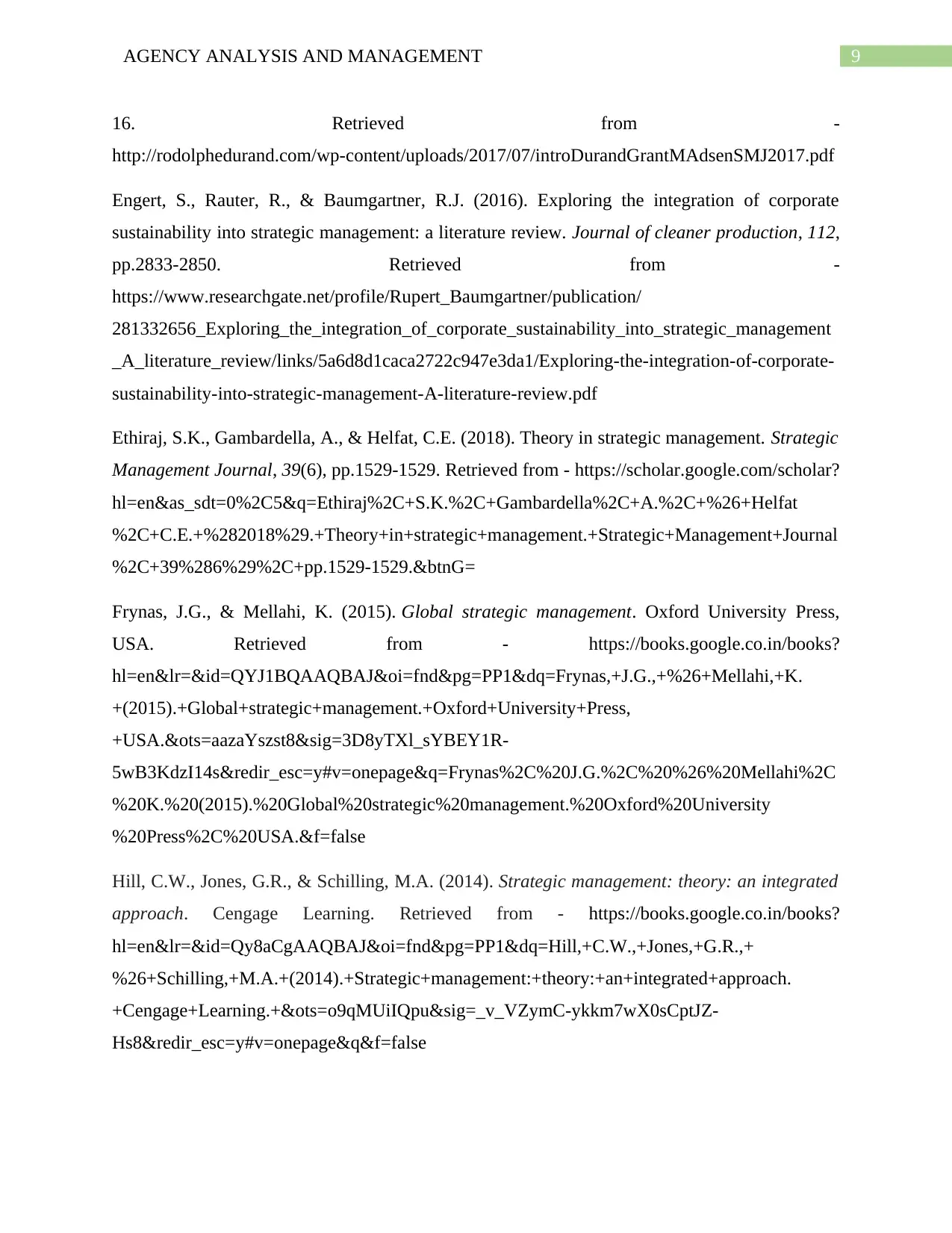
9AGENCY ANALYSIS AND MANAGEMENT
16. Retrieved from -
http://rodolphedurand.com/wp-content/uploads/2017/07/introDurandGrantMAdsenSMJ2017.pdf
Engert, S., Rauter, R., & Baumgartner, R.J. (2016). Exploring the integration of corporate
sustainability into strategic management: a literature review. Journal of cleaner production, 112,
pp.2833-2850. Retrieved from -
https://www.researchgate.net/profile/Rupert_Baumgartner/publication/
281332656_Exploring_the_integration_of_corporate_sustainability_into_strategic_management
_A_literature_review/links/5a6d8d1caca2722c947e3da1/Exploring-the-integration-of-corporate-
sustainability-into-strategic-management-A-literature-review.pdf
Ethiraj, S.K., Gambardella, A., & Helfat, C.E. (2018). Theory in strategic management. Strategic
Management Journal, 39(6), pp.1529-1529. Retrieved from - https://scholar.google.com/scholar?
hl=en&as_sdt=0%2C5&q=Ethiraj%2C+S.K.%2C+Gambardella%2C+A.%2C+%26+Helfat
%2C+C.E.+%282018%29.+Theory+in+strategic+management.+Strategic+Management+Journal
%2C+39%286%29%2C+pp.1529-1529.&btnG=
Frynas, J.G., & Mellahi, K. (2015). Global strategic management. Oxford University Press,
USA. Retrieved from - https://books.google.co.in/books?
hl=en&lr=&id=QYJ1BQAAQBAJ&oi=fnd&pg=PP1&dq=Frynas,+J.G.,+%26+Mellahi,+K.
+(2015).+Global+strategic+management.+Oxford+University+Press,
+USA.&ots=aazaYszst8&sig=3D8yTXl_sYBEY1R-
5wB3KdzI14s&redir_esc=y#v=onepage&q=Frynas%2C%20J.G.%2C%20%26%20Mellahi%2C
%20K.%20(2015).%20Global%20strategic%20management.%20Oxford%20University
%20Press%2C%20USA.&f=false
Hill, C.W., Jones, G.R., & Schilling, M.A. (2014). Strategic management: theory: an integrated
approach. Cengage Learning. Retrieved from - https://books.google.co.in/books?
hl=en&lr=&id=Qy8aCgAAQBAJ&oi=fnd&pg=PP1&dq=Hill,+C.W.,+Jones,+G.R.,+
%26+Schilling,+M.A.+(2014).+Strategic+management:+theory:+an+integrated+approach.
+Cengage+Learning.+&ots=o9qMUiIQpu&sig=_v_VZymC-ykkm7wX0sCptJZ-
Hs8&redir_esc=y#v=onepage&q&f=false
16. Retrieved from -
http://rodolphedurand.com/wp-content/uploads/2017/07/introDurandGrantMAdsenSMJ2017.pdf
Engert, S., Rauter, R., & Baumgartner, R.J. (2016). Exploring the integration of corporate
sustainability into strategic management: a literature review. Journal of cleaner production, 112,
pp.2833-2850. Retrieved from -
https://www.researchgate.net/profile/Rupert_Baumgartner/publication/
281332656_Exploring_the_integration_of_corporate_sustainability_into_strategic_management
_A_literature_review/links/5a6d8d1caca2722c947e3da1/Exploring-the-integration-of-corporate-
sustainability-into-strategic-management-A-literature-review.pdf
Ethiraj, S.K., Gambardella, A., & Helfat, C.E. (2018). Theory in strategic management. Strategic
Management Journal, 39(6), pp.1529-1529. Retrieved from - https://scholar.google.com/scholar?
hl=en&as_sdt=0%2C5&q=Ethiraj%2C+S.K.%2C+Gambardella%2C+A.%2C+%26+Helfat
%2C+C.E.+%282018%29.+Theory+in+strategic+management.+Strategic+Management+Journal
%2C+39%286%29%2C+pp.1529-1529.&btnG=
Frynas, J.G., & Mellahi, K. (2015). Global strategic management. Oxford University Press,
USA. Retrieved from - https://books.google.co.in/books?
hl=en&lr=&id=QYJ1BQAAQBAJ&oi=fnd&pg=PP1&dq=Frynas,+J.G.,+%26+Mellahi,+K.
+(2015).+Global+strategic+management.+Oxford+University+Press,
+USA.&ots=aazaYszst8&sig=3D8yTXl_sYBEY1R-
5wB3KdzI14s&redir_esc=y#v=onepage&q=Frynas%2C%20J.G.%2C%20%26%20Mellahi%2C
%20K.%20(2015).%20Global%20strategic%20management.%20Oxford%20University
%20Press%2C%20USA.&f=false
Hill, C.W., Jones, G.R., & Schilling, M.A. (2014). Strategic management: theory: an integrated
approach. Cengage Learning. Retrieved from - https://books.google.co.in/books?
hl=en&lr=&id=Qy8aCgAAQBAJ&oi=fnd&pg=PP1&dq=Hill,+C.W.,+Jones,+G.R.,+
%26+Schilling,+M.A.+(2014).+Strategic+management:+theory:+an+integrated+approach.
+Cengage+Learning.+&ots=o9qMUiIQpu&sig=_v_VZymC-ykkm7wX0sCptJZ-
Hs8&redir_esc=y#v=onepage&q&f=false
Paraphrase This Document
Need a fresh take? Get an instant paraphrase of this document with our AI Paraphraser
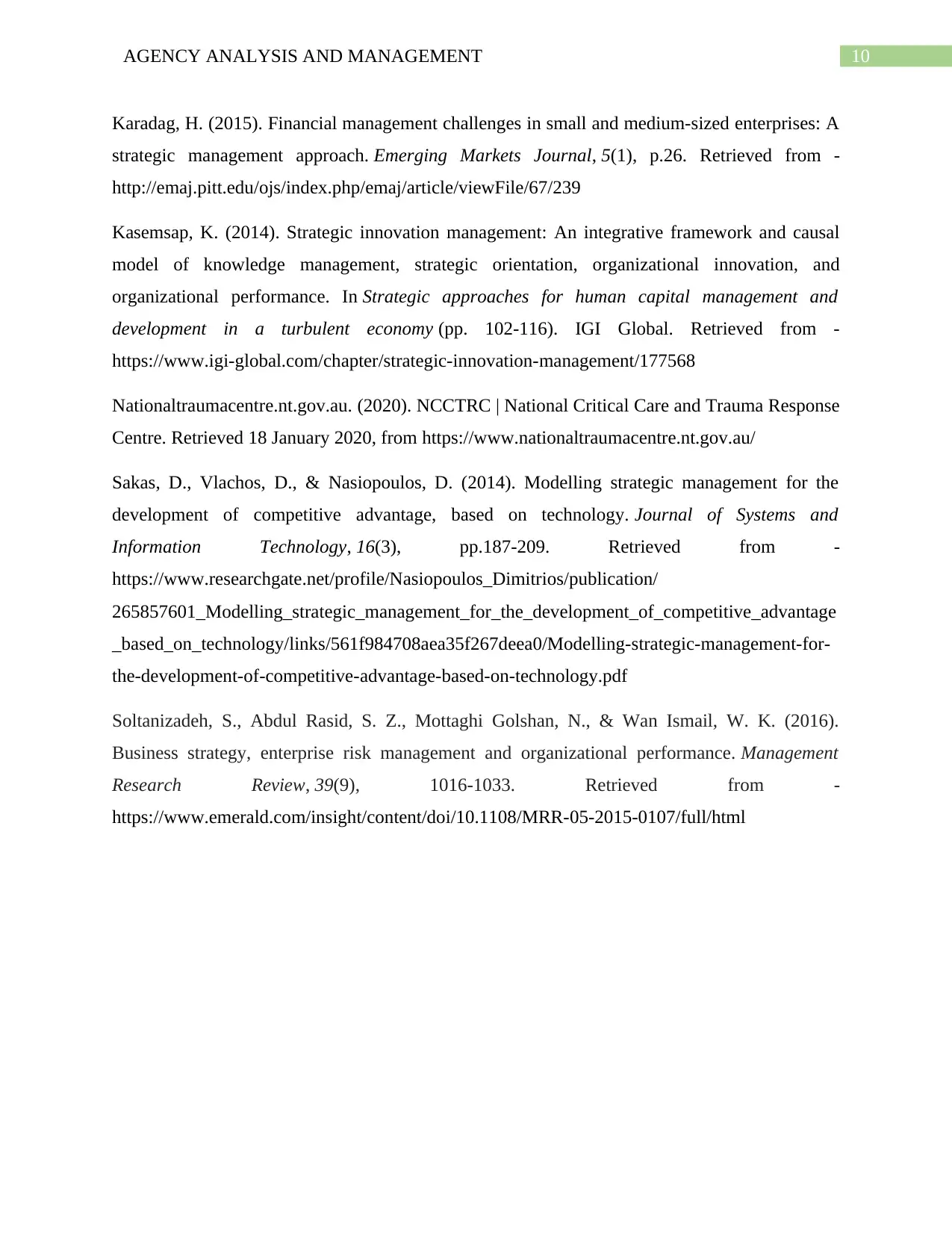
10AGENCY ANALYSIS AND MANAGEMENT
Karadag, H. (2015). Financial management challenges in small and medium-sized enterprises: A
strategic management approach. Emerging Markets Journal, 5(1), p.26. Retrieved from -
http://emaj.pitt.edu/ojs/index.php/emaj/article/viewFile/67/239
Kasemsap, K. (2014). Strategic innovation management: An integrative framework and causal
model of knowledge management, strategic orientation, organizational innovation, and
organizational performance. In Strategic approaches for human capital management and
development in a turbulent economy (pp. 102-116). IGI Global. Retrieved from -
https://www.igi-global.com/chapter/strategic-innovation-management/177568
Nationaltraumacentre.nt.gov.au. (2020). NCCTRC | National Critical Care and Trauma Response
Centre. Retrieved 18 January 2020, from https://www.nationaltraumacentre.nt.gov.au/
Sakas, D., Vlachos, D., & Nasiopoulos, D. (2014). Modelling strategic management for the
development of competitive advantage, based on technology. Journal of Systems and
Information Technology, 16(3), pp.187-209. Retrieved from -
https://www.researchgate.net/profile/Nasiopoulos_Dimitrios/publication/
265857601_Modelling_strategic_management_for_the_development_of_competitive_advantage
_based_on_technology/links/561f984708aea35f267deea0/Modelling-strategic-management-for-
the-development-of-competitive-advantage-based-on-technology.pdf
Soltanizadeh, S., Abdul Rasid, S. Z., Mottaghi Golshan, N., & Wan Ismail, W. K. (2016).
Business strategy, enterprise risk management and organizational performance. Management
Research Review, 39(9), 1016-1033. Retrieved from -
https://www.emerald.com/insight/content/doi/10.1108/MRR-05-2015-0107/full/html
Karadag, H. (2015). Financial management challenges in small and medium-sized enterprises: A
strategic management approach. Emerging Markets Journal, 5(1), p.26. Retrieved from -
http://emaj.pitt.edu/ojs/index.php/emaj/article/viewFile/67/239
Kasemsap, K. (2014). Strategic innovation management: An integrative framework and causal
model of knowledge management, strategic orientation, organizational innovation, and
organizational performance. In Strategic approaches for human capital management and
development in a turbulent economy (pp. 102-116). IGI Global. Retrieved from -
https://www.igi-global.com/chapter/strategic-innovation-management/177568
Nationaltraumacentre.nt.gov.au. (2020). NCCTRC | National Critical Care and Trauma Response
Centre. Retrieved 18 January 2020, from https://www.nationaltraumacentre.nt.gov.au/
Sakas, D., Vlachos, D., & Nasiopoulos, D. (2014). Modelling strategic management for the
development of competitive advantage, based on technology. Journal of Systems and
Information Technology, 16(3), pp.187-209. Retrieved from -
https://www.researchgate.net/profile/Nasiopoulos_Dimitrios/publication/
265857601_Modelling_strategic_management_for_the_development_of_competitive_advantage
_based_on_technology/links/561f984708aea35f267deea0/Modelling-strategic-management-for-
the-development-of-competitive-advantage-based-on-technology.pdf
Soltanizadeh, S., Abdul Rasid, S. Z., Mottaghi Golshan, N., & Wan Ismail, W. K. (2016).
Business strategy, enterprise risk management and organizational performance. Management
Research Review, 39(9), 1016-1033. Retrieved from -
https://www.emerald.com/insight/content/doi/10.1108/MRR-05-2015-0107/full/html
1 out of 11
Related Documents
Your All-in-One AI-Powered Toolkit for Academic Success.
+13062052269
info@desklib.com
Available 24*7 on WhatsApp / Email
![[object Object]](/_next/static/media/star-bottom.7253800d.svg)
Unlock your academic potential
Copyright © 2020–2025 A2Z Services. All Rights Reserved. Developed and managed by ZUCOL.





